Physical Address
304 North Cardinal St.
Dorchester Center, MA 02124
Myxoid tumors of soft tissue are remarkable for their characteristic abundant extracellular matrix material. This heterogeneous group of lesions includes benign (and self-limited) tumors, those with a significant potential for local recurrence, and sarcomas. Because there is considerable clinical and histologic overlap, myxoid soft tissue tumors can pose problems in differential diagnosis. Immunohistochemistry is of limited help in distinguishing among the fibroblastic/myofibroblastic lesions in this group, although it can be very helpful to confirm the line of differentiation for other tumors with myxoid stroma. Other ancillary tools such as cytogenetics and molecular genetics can also corroborate the diagnosis of several lesions in this category ( Box 5.1 ).
Ganglion cyst
Intramuscular/cellular myxoma
Juxtaarticular myxoma
Dermal nerve sheath myxoma
Superficial acral fibromyxoma (digital fibromyxoma)
Superficial angiomyxoma
Deep (“aggressive”) angiomyxoma
Myoepithelioma
Ossifying fibromyxoid tumor (usually)
Myxoinflammatory fibroblastic sarcoma
Myoepithelial carcinoma
Ossifying fibromyxoid tumor (rarely)
Myxofibrosarcoma
Myxoid liposarcoma
Extraskeletal myxoid chondrosarcoma
Low-grade fibromyxoid sarcoma
It is helpful to pay attention to several key features when encountering a myxoid soft tissue tumor, including depth (dermal, subcutaneous, or subfascial), the extent of myxoid stroma (abundant or limited; diffuse or focal), the presence (or absence) of nuclear pleomorphism, and the presence of distinctive vasculature. For example, intramuscular/cellular myxoma lacks nuclear atypia, in contrast to myxofibrosarcoma, which contains pleomorphic cells, even in low-grade examples. Myxoid liposarcoma is characterized by thin-walled, branching (“crow's feet”) blood vessels, whereas low-grade fibromyxoid sarcoma (LGFMS) contains arcades of thin-walled vessels. Therefore extensive sampling of these tumors, with attention to such morphologic cues, is critical for the proper analysis of these neoplasms ( Boxes 5.2–5.5 ).
Ganglion cyst
Dermal nerve sheath myxoma
Superficial acral fibromyxoma (digital fibromyxoma)
Superficial angiomyxoma
Juxtaarticular myxoma
Soft tissue myoepithelioma
Ossifying fibromyxoid tumor
Myxofibrosarcoma (two thirds of cases)
Myxoinflammatory fibroblastic sarcoma
Intramuscular/cellular myxoma
Deep angiomyxoma
Soft tissue myoepithelioma and myoepithelial carcinoma
Myxoid liposarcoma
Myxofibrosarcoma (one third of cases)
Extraskeletal myxoid chondrosarcoma
Low-grade fibromyxoid sarcoma
Superficial acral fibromyxoma (digital fibromyxoma)
Ossifying fibromyxoid tumor
Low-grade fibromyxoid sarcoma
Intramuscular/cellular myxoma
Juxtaarticular myxoma
Dermal nerve sheath myxoma
Superficial angiomyxoma
Deep angiomyxoma
Myxoinflammatory fibroblastic sarcoma
Myxofibrosarcoma (especially low-grade tumors)
Myxoid liposarcoma
Extraskeletal myxoid chondrosarcoma
Ganglion cyst
Myoepithelioma and myoepithelial carcinoma
Myxoinflammatory fibroblastic sarcoma
Myoepithelial carcinoma
Myxofibrosarcoma
Deep angiomyxoma: perivascular hyalinization with smooth muscle cells spinning off of vessels
Myxofibrosarcoma: curvilinear vessels
Myxoid liposarcoma: thin-walled, branching capillaries (“crow's feet” or “chicken-wire” pattern)
Low-grade fibromyxoid sarcoma: arcades of blood vessels
The differential diagnosis of myxoid mesenchymal tumors also includes select soft tissue neoplasms that only occasionally display prominent myxoid stroma, such as peripheral nerve sheath tumors, dermatofibrosarcoma protuberans (DFSP), synovial sarcoma, and solitary fibrous tumor (SFT). Although immunohistochemistry can aid in the proper diagnosis of several of these tumor types (such as S-100 protein for nerve sheath tumors and epithelial membrane antigen [EMA], keratins, and TLE1 for synovial sarcoma), proper diagnosis often relies on identifying areas with conventional histologic features. Nonmesenchymal tumors, such as carcinoma and melanoma, very rarely show significant myxoid stroma.
Ganglion cyst is a common reactive lesion of soft tissue that appears to result from myxoid degeneration of connective tissue as a result of trauma. It is commonly identified on imaging studies; on computed tomography scan, it appears as an oval or round lesion with uniform low signal intensity on T1-weighted images and high signal on T2-weighted images.
Ganglion cyst is one of the most common soft tissue lesions of the hands and wrists. It can also affect other joints, such as the knee, ankle, and foot. Men are affected slightly more often than women. Most patients are between the fourth and sixth decades of life.
Although patients are often asymptomatic, pain or a palpable lesion is occasionally present.
Grossly, ganglion cysts are small, well-circumscribed lesions, with a thick fibrous pseudocapsule, attached to tendons or bursae. Occasionally, there may be communication with the underlying joint space.
Histologically, cysts may be uni- or multiloculated; filled with clear, acellular, viscous fluid; and lined by flat cells, which are likely fibroblastic/myofibroblastic in origin. Not uncommonly, ganglion cysts may rupture and extravasated fluid dissects into adjacent connective tissues ( Fig. 5.1 ). Ruptured ganglion cysts may be mistaken for other myxoid lesions of soft tissue.
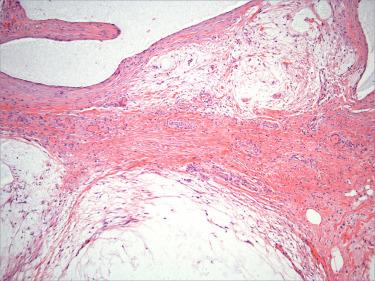
Ganglion cyst should be distinguished from juxtaarticular myxoma and myxoinflammatory fibroblastic sarcoma. Juxtaarticular myxoma often affects larger joints, such as the knee, as well as the elbow, shoulder, ankle, and hip. Histologically, juxtaarticular myxoma is a variably cellular spindle cell lesion with prominent myxoid stroma and ill-defined borders, more cellular than ganglion cyst. Myxoinflammatory fibroblastic sarcoma shows a predilection for the distal extremities. It is a low-grade sarcoma characterized by alternating hypo- and hypercellular areas and containing a prominent chronic inflammatory infiltrate and scattered large atypical pleomorphic cells with prominent nucleoli. In contrast, ganglion cysts typically lack an inflammatory component and do not contain atypical cells.
Symptomatic ganglion cysts can be treated by simple excision or aspiration. Recurrences are uncommon.
The term intramuscular myxoma was coined by Stout; in 1965 Enzinger reported the first large series of intramuscular myxomas, a group of deep-seated, benign-appearing soft tissue tumors showing abundant myxoid stroma. Tumors showing higher cellularity and more collagenous stroma are designated “cellular myxoma.” Intramuscular/cellular myxoma may occur sporadically or in association with fibrous dysplasia (also known as Mazabraud syndrome ).
Intramuscular myxoma affects middle-aged adults (median age, 50 to 60 years) with a female predominance (female-to-male ratio, 3 : 1). Most patients present with a painless, slowly growing mass. Tumors most frequently arise in the lower extremities, especially the thigh. The vast majority of lesions are intramuscular, and a smaller subset arise in subcutaneous tissue.
Grossly, intramuscular myxomas are usually between 5 and 10 cm and appear well circumscribed, with a thin fibrous pseudocapsule. The cut surface is usually gelatinous and may show areas of cystic change.
Histologically, classic intramuscular myxoma is uniformly hypocellular and composed of small, bland spindle and stellate-shaped cells, with oval nuclei, inconspicuous nucleoli, and small amounts of palely eosinophilic cytoplasm, embedded in an abundant myxoid matrix ( Fig. 5.2 ). Scattered small blood vessels are often present. Tumors frequently infiltrate adjacent muscle and adipose tissue. Mitoses are rare, and necrosis is absent.
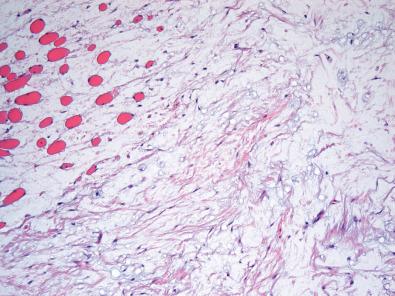
A subset of intramuscular myxomas show hypercellular areas that may be focal or diffuse. Such tumors are referred to as “cellular myxomas” ( Fig. 5.3A ). These neoplasms are composed of cells with cytologic features similar to those of intramuscular myxoma. No atypia, nuclear pleomorphism, or mitotic activity is observed in cellular myxoma (see Fig. 5.3B ). In addition, the stroma in cellular myxoma is more collagenous than in conventional intramuscular myxoma.
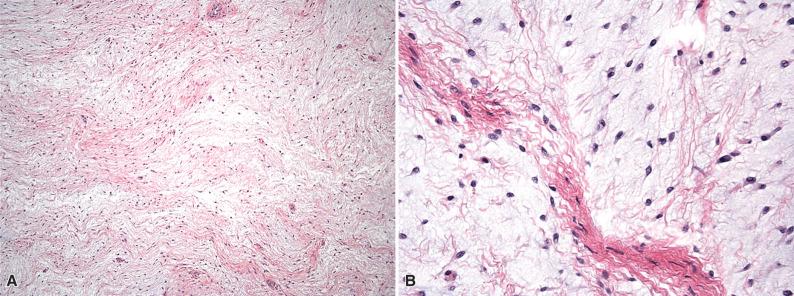
Intramuscular and cellular myxomas are often positive for CD34 and are negative for smooth muscle actin (SMA), desmin, and S-100 protein; EMA may be focally positive, most often in core needle biopsy specimens, a potential diagnostic pitfall.
Both intramuscular and cellular myxomas, whether sporadic or associated with Mazabraud syndrome, often harbor activating mutations in codon 201 of the GNAS gene, which encodes for the α subunit of the G protein that stimulates cyclic adenosine monophosphate formation. A recent study found no GNAS mutations in juxtaarticular myxomas, which suggests that intramuscular/cellular myxomas are distinct from juxtaarticular myxomas (discussed later).
The differential diagnosis of intramuscular/cellular myxoma includes low-grade myxofibrosarcoma, LGFMS, and myxoid nerve sheath tumors, in particular myxoid neurofibroma and soft tissue perineurioma.
Similar to intramuscular/cellular myxoma, low-grade myxofibrosarcoma affects older adults and often arises in the thigh. However, myxofibrosarcoma usually occurs in subcutaneous tissue and involves the skin, which is rarely the case in intramuscular/cellular myxoma. Low-grade myxofibrosarcoma can be distinguished from intramuscular myxoma based on the presence of distinctive curvilinear blood vessels and scattered atypical pleomorphic cells.
Typically, LGFMS affects younger patients than intramuscular/cellular myxoma. Morphologically, it shows alternating myxoid and collagenous areas, with arcades of thin-walled blood vessels. LGFMS can be distinguished from intramuscular/cellular myxoma by a more uniformly cellular appearance, expression of MUC4 and often EMA, and the characteristic t(7;16) translocation involving the FUS gene, which can be detected by conventional cytogenetics or fluorescence in situ hybridization (FISH) studies.
Myxoid neurofibroma contains cells with wavy, tapering nuclei and shows positive staining for S-100 protein. Soft tissue perineurioma may have variably myxoid stroma, but usually shows a whorled architecture and contains slender cells with elongated bipolar cytoplasmic processes, which are positive for EMA and often for claudin-1. As intramuscular/cellular myxoma often shows staining for EMA in core needle biopsy specimens, it is not always possible to distinguish between perineurioma and intramuscular/cellular myxoma in limited samples ; in such cases, an interim diagnosis of “benign myxoid spindle cell neoplasm” is appropriate.
Intramuscular and cellular myxomas have a low risk of local recurrence if incompletely excised; therefore, simple surgical excision is adequate therapy.
Occurs sporadically or as part of Mazabraud syndrome.
Affects middle-aged adults, with female predominance.
Arises most frequently in the lower extremity and is often intramuscular.
Intramuscular myxoma is a hypocellular myxoid lesion with bland cytology, inconspicuous vessels, and nondestructive infiltration of adjacent tissues.
Cellular myxoma is more cellular, more collagenous, and more vascular than conventional intramuscular myxoma.
Lesions are negative for S-100 protein; EMA may be positive in core needle biopsies.
Contains activating mutations in codon 201 of the GNAS gene.
Juxtaarticular myxoma is a benign myxoid lesion that morphologically resembles intramuscular/cellular myxoma; however, these lesions appear to be distinct, based on recent genetic analysis.
Men are affected more often than women (male-to-female ratio, 2.6 : 1). The age range is wide, but most patients are between the fifth and sixth decades. Juxtaarticular myxoma usually arises adjacent to large joints, with the knee the most commonly affected site (>85% of cases), followed by the shoulder, elbow, hip, and ankle. Patients come to medical attention because of a mass lesion with occasional pain or tenderness. Rarely, patients report a history of trauma or osteoarthritis at the involved site.
Grossly, most tumors are between 2 and 6 cm, with a mucoid or gelatinous cut surface and a soft consistency. Areas of cystic degeneration are often present.
Histologically, juxtaarticular myxoma shows an infiltrative growth pattern with entrapment of adjacent subcutaneous adipose or tendinous tissue. The cells are uniform, with small, ovoid nuclei and inconspicuous nucleoli, embedded in a myxoid stroma. Most lesions are hypocellular; however, areas of increased cellularity (resembling cellular myxoma, discussed earlier) are common ( Fig. 5.4 ). Most lesions (90%) show areas of ganglion cyst-like features with a fibrous pseudocapsule and accumulation of acellular myxoid matrix. In addition, foci of hemorrhage, chronic inflammation, and fibrin deposition may be seen in a subset of cases, likely secondary to trauma.

The immunophenotype is nonspecific, with variable positivity for CD34 and SMA, and negativity for S-100 protein.
It appears that juxtaarticular myxoma lacks the activating GNAS gene mutations characteristic of intramuscular and cellular myxomas, suggesting that intramuscular/cellular myxoma and juxtaarticular myxoma are unrelated, despite their histologic similarities.
The differential diagnosis for juxtaarticular myxoma includes ganglion cyst, intramuscular myxoma, and low-grade myxofibrosarcoma.
In contrast to juxtaarticular myxoma, ganglion cysts mainly affect the small joints of the hands and feet and are characterized by the accumulation of acellular mucin surrounded by a dense fibrous pseudocapsule. When the capsule is disrupted, mucin can dissect through adjacent tissues with a pseudoinfiltrative growth pattern that is reminiscent of juxtaarticular myxoma.
The histologic features are essentially identical to those of intramuscular/cellular myxoma, and the two conditions can be distinguished only by anatomic location (adjacent to joints, in contrast to within large muscles).
Myxofibrosarcoma usually arises in superficial soft tissues of the extremities; joints are rarely involved. Histologically, myxofibrosarcoma can be distinguished from juxtaarticular myxoma by the presence of nuclear atypia and characteristic curvilinear blood vessels.
In approximately 35% of cases, juxtaarticular myxoma recurs locally but does not metastasize. Complete surgical excision is adequate treatment.
Predilection for men between fifth and sixth decades
Juxtaarticular myxoma occurs in the large joints; the knee is involved in more than 85% of cases.
Hypocellular myxoid lesion with bland cytology (similar to intramuscular myxoma) and infiltrative growth pattern.
Lacks activating mutations of GNAS gene.
Recurs in approximately 35% of cases, but shows no metastatic potential.
Until recently, dermal nerve sheath myxoma (formerly also referred to as myxoid neurothekeoma ) was believed to be related to cellular neurothekeoma because the latter lesion may show myxoid stromal change. However, it is now clear that these two lesions are unrelated and show distinct clinical and immunohistochemical features (nerve sheath myxoma is an S-100 protein-positive true Schwann cell neoplasm, whereas cellular neurothekeoma shows no specific immunophenotype), as well as differences in recurrent potential. Dermal nerve sheath myxoma is also discussed in Chapter 15 .
Dermal nerve sheath myxoma affects men and women equally, with a predilection for younger adults (mean age, 35 years). Patients typically present with small, painless nodules on the distal extremities.
Dermal nerve sheath myxoma is a well-circumscribed small nodule, usually between 0.5 and 2 cm, primarily involving the dermis, with frequent extension into subcutaneous tissue. These tumors show a lobulated growth pattern, with sharply demarcated lobules separated by fibrous tissue ( Fig. 5.5A ). The lobules contain abundant myxoid matrix, with tumor cells growing in a reticular pattern; tumor cells may be arranged in circular, ring-like structures at the periphery of lobules (see Fig. 5.5B ). Neoplastic cells are spindled to stellate, with hyperchromatic nuclei and scant cytoplasm (see Fig. 5.5C ). Mitoses are scarce and nuclear pleomorphism is minimal.
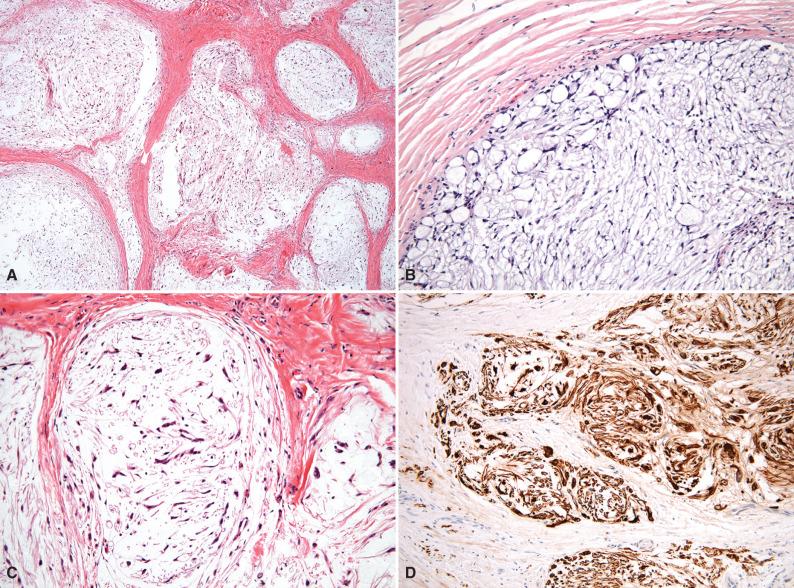
Dermal nerve sheath myxoma diffusely expresses S-100 protein (see Fig. 5.5D ) as well as glial fibrillary acidic protein (GFAP) in most cases, confirming the Schwann cell nature of this tumor type.
The differential diagnoses include cellular neurothekeoma, plexiform neurofibroma, superficial angiomyxoma, and low-grade myxofibrosarcoma. Immunohistochemical studies are helpful in this distinction.
Cellular neurothekeoma shows a predilection for the head and neck and upper extremities, and rarely affects the fingers and toes (see Chapter 15 ). In contrast to dermal nerve sheath myxoma, cellular neurothekeoma is poorly circumscribed with a micronodular architecture and is composed of nests of predominantly epithelioid cells with abundant pale cytoplasm. Myxoid stroma may be present, but it rarely predominates. Cellular neurothekeoma is positive for NKI-C3 and negative for S-100 protein.
Plexiform neurofibroma is essentially pathognomonic of neurofibromatosis type 1 (von Recklinghausen disease). This neurofibroma variant often occurs in superficial locations and shows a multinodular (or plexiform) growth pattern. However, in contrast to dermal nerve sheath myxoma, tumor nodules in plexiform neurofibroma are not surrounded by a thick, fibrous capsule. Occasional cases may show stromal myxoid changes, but unlike dermal nerve sheath myxoma, these lesions are not uniformly myxoid. Neurofibromas are usually less diffusely positive for S-100 protein and may show patchy expression of EMA; neurofilament protein highlights scattered axons.
Superficial angiomyxoma shows a predilection for the trunk and head and neck, and is rare in the distal extremities. The tumor is poorly circumscribed, with ill-defined lobules that lack the sharp circumscription of dermal nerve sheath myxoma. Stromal neutrophils are seen in half of cases. In contrast to dermal nerve sheath myxoma, neoplastic cells are negative for S-100 protein.
Myxofibrosarcoma is often superficial and primarily affects the extremities of elderly patients. It is an infiltrative neoplasm with a lobulated growth pattern. In contrast to dermal nerve sheath myxoma, low-grade myxofibrosarcoma contains distinctive curvilinear blood vessels and scattered atypical hyperchromatic cells and is negative for S-100 protein.
Dermal nerve sheath myxoma shows a relatively high rate of nondestructive local recurrence (up to 45%) after simple excision. There is no metastatic potential.
Although superficial acral fibromyxoma (also known as digital fibromyxoma) is a relatively common lesion, it remains underrecognized. This tumor type is also discussed in Chapter 15 .
Superficial acral fibromyxoma affects adults and shows a slight male predominance, with the majority arising as painless nodules on the fingers and toes, usually in the periungual regions.
Superficial acral fibromyxoma is usually a small polypoid or dome-shaped skin lesion, without ulceration of the overlying epidermis. It is a poorly circumscribed and unencapsulated, predominantly dermal cellular proliferation of elongated or stellate, cytologically uniform bland fibroblasts, arranged in a haphazard pattern ( Fig. 5.6A ). Tumor cells are embedded in a variably collagenous or myxoid stroma and show no nuclear atypia (see Fig. 5.6B ). Mitoses are rare, and necrosis is not observed.
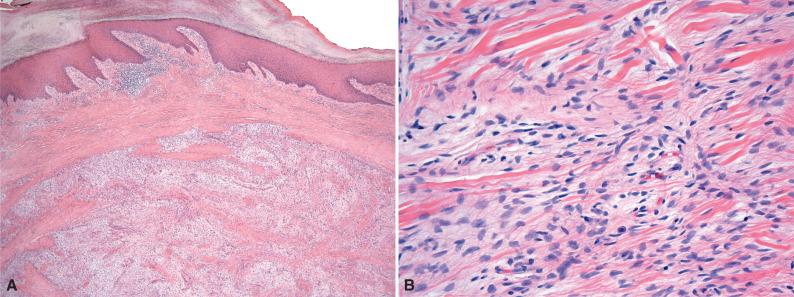
Immunohistochemistry is of limited value in the diagnosis of superficial acral fibromyxoma. Neoplastic cells are usually diffusely positive for CD34 and may occasionally show reactivity for EMA, whereas S-100 protein is negative. Loss of RB1 (retinoblastoma) expression appears to be common in this tumor type.
Become a Clinical Tree membership for Full access and enjoy Unlimited articles
If you are a member. Log in here